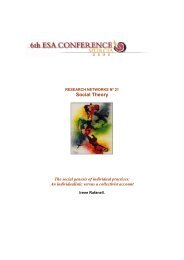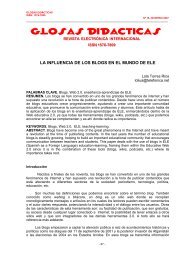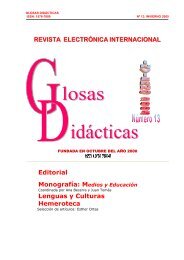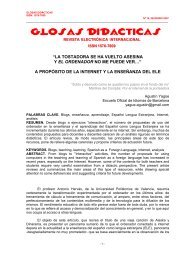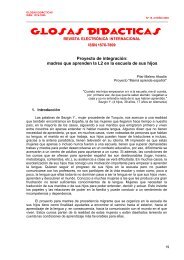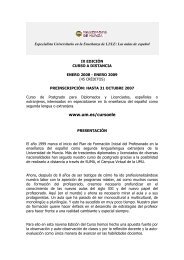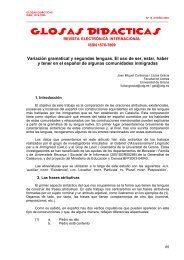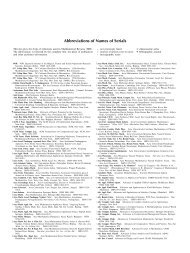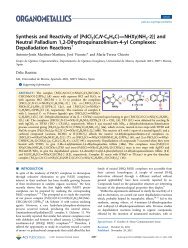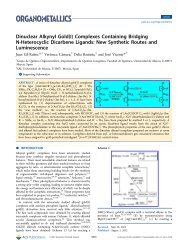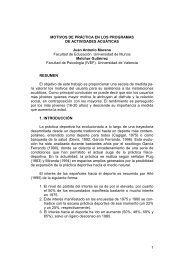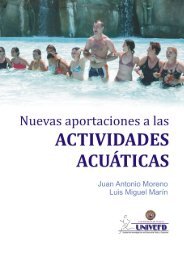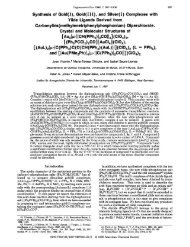Osmolyte concentrations in Atriplex halimus L. and Atriplex ...
Osmolyte concentrations in Atriplex halimus L. and Atriplex ...
Osmolyte concentrations in Atriplex halimus L. and Atriplex ...
You also want an ePaper? Increase the reach of your titles
YUMPU automatically turns print PDFs into web optimized ePapers that Google loves.
Anales de Biología 33: 117-126, 2011 ARTICLE<br />
<strong>Osmolyte</strong> <strong>concentrations</strong> <strong>in</strong> <strong>Atriplex</strong> <strong>halimus</strong> L. <strong>and</strong> <strong>Atriplex</strong><br />
canescens (Pursh) Nutt. adapted to sal<strong>in</strong>ity <strong>and</strong> low<br />
temperature (Chenopodiaceae)<br />
Miloud Aouissat 1 , David J. Walker 2 , Kheiria Hc<strong>in</strong>i 3 , Moulay Belkhodja 4 & Enrique Correal 2<br />
1 Département de Biologie, Faculté des Sciences et des Technologies: Université Dr Tahar Moulay. SAIDA 20000, Algérie.<br />
2 Departamento de Recursos Naturales: Instituto Murciano de Investigación y Desarrollo Agrario y Alimentario (IMIDA),<br />
Estación Sericícola, Calle Mayor, s/n, La Alberca, 30150 Murcia, España.<br />
3 Département des Sciences Biologiques, Faculté des Sciences de Tunis, Université de Tunis 2092 El Manar, Tunisie.<br />
4 Département de Biologie, Laboratoire de Physiologie Végétale, Faculté des Sciences Université d’Oran sénia, Algérie.<br />
Correspondence<br />
K. Hc<strong>in</strong>i<br />
E-mail: hc<strong>in</strong>ikheiria@yahoo.fr<br />
Received: 24 May 2010<br />
Accepted: 19 September 2011<br />
Published on-l<strong>in</strong>e: 12 December 2011<br />
Resumen<br />
Concentración de osmolitos en <strong>Atriplex</strong> <strong>halimus</strong> L. y <strong>Atriplex</strong><br />
canescens (Pursh) Nutt. adaptados a sal<strong>in</strong>idad y bajas temperaturas<br />
(Chenopodiaceae)<br />
En este trabajo hemos <strong>in</strong>vestigado los efectos de la tolerancia a la<br />
congelación de <strong>Atriplex</strong> <strong>halimus</strong> y <strong>Atriplex</strong> canescens de diferentes poblaciones<br />
de Argelia. La tolerancia al frío se determ<strong>in</strong>ó mediante ensayos<br />
de pérdida de electrolitos en hojas de plantas que crecieron durante<br />
tres meses en maceta más un mes de aclimatación al frío. Para A.<br />
<strong>halimus</strong> se determ<strong>in</strong>ó el efecto que producía el <strong>in</strong>cremento de sal<strong>in</strong>idad<br />
en el suelo sobre la tolerancia al frío, compar<strong>and</strong>o los niveles de<br />
cationes y osmolitos orgánicos en hojas de plantas que crecieron en<br />
soluciones sal<strong>in</strong>as, con los de plantas que únicamente habían sido<br />
aclimatadas al frío. Se encontró una relación significativa entre la tolerancia<br />
al frío y la concentración de Na y Na + K en tejidos. Se relacionan<br />
los cambios en la concentración de osmolitos bajo condiciones de<br />
sal<strong>in</strong>idad (cultivo hidropónico) con los cambios producidos mediante la<br />
<strong>in</strong>teración de aclimatación al frío más sal<strong>in</strong>idad del suelo.<br />
Palabras clave: <strong>Atriplex</strong> <strong>halimus</strong>, <strong>Atriplex</strong> canescens, Cationes,<br />
Halofitos, Sal<strong>in</strong>idad, Solutos compatibles, Tolerancia al frío.<br />
Abstract<br />
We <strong>in</strong>vestigated the effects of cold (freez<strong>in</strong>g) tolerance for <strong>Atriplex</strong><br />
<strong>halimus</strong> <strong>and</strong> <strong>Atriplex</strong> canescens (Chenopodiaceae) from different locations<br />
<strong>in</strong> Algeria. Plants were grown <strong>in</strong> pots of soil for three months,<br />
after a one-month acclimation period, the cold tolerance was determ<strong>in</strong>ed,<br />
<strong>in</strong> leaf electrolyte leakage assays. For A. <strong>halimus</strong>, the effect of <strong>in</strong>creased<br />
soil sal<strong>in</strong>ity (addition of NaCl) on tolerance was determ<strong>in</strong>ed<br />
<strong>and</strong> the cold-acclimated plants were compared with those grown <strong>in</strong> sal<strong>in</strong>e<br />
nutrient solution, <strong>in</strong> relation to leaf levels of cations <strong>and</strong> organic osmolytes.<br />
There was significant correlation between the cold tolerance<br />
<strong>and</strong> the leaf tissue water <strong>concentrations</strong> of Na <strong>and</strong> Na+K. Here we relate<br />
changes <strong>in</strong> osmolyte concentration under cold acclimation/soil sal<strong>in</strong>isation.<br />
Key words: <strong>Atriplex</strong> <strong>halimus</strong>, <strong>Atriplex</strong> canescens, cations, cold<br />
tolerance, compatible solutes, halophytes, sal<strong>in</strong>ity.
118 M. Aouissat et al. Anales de Biología 33, 2011<br />
Introduction<br />
<strong>Atriplex</strong> <strong>halimus</strong> L. (Chenopodiaceae) (Saltbush)<br />
is a perennial C4 shrub which grows throughout<br />
the Mediterranean bas<strong>in</strong> <strong>and</strong> is used widely to<br />
provide forage, due to its drought <strong>and</strong> salt tolerance<br />
<strong>and</strong> its high prote<strong>in</strong> content (Le Houérou,<br />
1992). <strong>Atriplex</strong> canescens (Pursh) Nutt. (fourw<strong>in</strong>g<br />
saltbush) orig<strong>in</strong>ates from North America <strong>and</strong> possesses<br />
numerous ploidy levels, from diploid (2n =<br />
2x = 18) to dodecaploid (2n = 12x = 108), which<br />
contribute to its adaptation to diverse environmental<br />
conditions (S<strong>and</strong>erson et al. 1989). In Algeria,<br />
A. <strong>halimus</strong> is autochthonous whereas A.<br />
canescens was <strong>in</strong>troduced <strong>in</strong> 1987, as a source of<br />
fodder <strong>in</strong> plantations. Here, these two species are<br />
grown over a wide range of soil sal<strong>in</strong>ity <strong>and</strong> m<strong>in</strong>imum<br />
w<strong>in</strong>ter temperatures, from coastal areas to<br />
mounta<strong>in</strong>ous areas at more than 1100 m altitude.<br />
Although <strong>Atriplex</strong> species are relatively coldtolerant<br />
C4 plants (Caldwell et al. 1977), their distribution<br />
<strong>and</strong> biomass production are restricted by<br />
sub-zero temperatures. Freez<strong>in</strong>g damage arises<br />
ma<strong>in</strong>ly from the formation of ice <strong>in</strong> <strong>in</strong>tercellular<br />
spaces, <strong>and</strong> the consequent cellular dehydration<br />
(X<strong>in</strong> & Browse 2000). The physiological factors<br />
related to plant cold (freez<strong>in</strong>g) tolerance <strong>in</strong>clude<br />
raised tissue <strong>concentrations</strong> of am<strong>in</strong>o acids, prol<strong>in</strong>e,<br />
soluble sugars <strong>and</strong> quaternary ammonium<br />
compounds (QACs), such as beta<strong>in</strong>e (Chen & Li<br />
1977, Thomas & James 1993, Allard et al. 1998,<br />
Sakamoto et al. 2000, X<strong>in</strong> & Browse 2000). Organic<br />
osmotica contribute to osmotic adjustment<br />
(OA) <strong>and</strong> also protect the structural <strong>in</strong>tegrity of<br />
cell membranes <strong>and</strong> prote<strong>in</strong>s (X<strong>in</strong> & Browse<br />
2000). In halophytes, such as A. <strong>halimus</strong>, OA <strong>in</strong><br />
response to sal<strong>in</strong>ity or drought, which also cause<br />
Species Population<br />
Latitude<br />
(N)<br />
Longitude Altitude<br />
(msl)<br />
A. <strong>halimus</strong><br />
El Biodh<br />
El Kasdir<br />
33º54´27´´<br />
33º42´52´´<br />
00º20´43´´ W<br />
01º23´31´´ W<br />
El Kheiter 34º08´29´´ 00º04´15´´ E<br />
Maamoura 34º37´29´´ 00º33´00´´ E<br />
A. canescens<br />
Oran<br />
A<strong>in</strong> El Ha I<br />
35º38´23´´<br />
34º45´31´´<br />
00º36´46´´ W<br />
00º07´08´´ E<br />
A<strong>in</strong> El Ha II 34º45´42´´ 00º08´50´´ E<br />
Maamoura 34º36´34´´ 00º33´03´´ E<br />
989<br />
981<br />
989<br />
1106<br />
92<br />
1008<br />
1036<br />
1106<br />
cellular dehydration, <strong>in</strong>volves vacuolar accumulation<br />
of <strong>in</strong>organic ions; simultaneously, compatible<br />
organic osmotica accumulate <strong>in</strong> the cytoplasm to<br />
ma<strong>in</strong>ta<strong>in</strong> an osmotic equilibrium across the tonoplast<br />
(Matoh et al. 1987, Bajji et al. 1998,<br />
Martínez et al. 2003, 2004).<br />
The aim of this work was to characterise cold<br />
tolerance <strong>in</strong> A. <strong>halimus</strong> <strong>and</strong> A. canescens populations<br />
from Algeria <strong>and</strong>, for two populations of A.<br />
<strong>halimus</strong>, determ<strong>in</strong>e the effect of soil sal<strong>in</strong>ity on<br />
cold tolerance. We also compared plants exposed<br />
to sal<strong>in</strong>ity <strong>in</strong> nutrient solution, <strong>and</strong> cold-acclimated<br />
plants, subjected to decreas<strong>in</strong>g temperature<br />
<strong>and</strong> day length, with respect to tissue levels of<br />
cations <strong>and</strong> organic osmotica. The results will be<br />
used for selection of species <strong>and</strong> populations for<br />
use under particular conditions of soil sal<strong>in</strong>ity <strong>and</strong><br />
w<strong>in</strong>ter temperatures.<br />
Material <strong>and</strong> methods<br />
Area of study<br />
Tabla 1. Localización de las poblaciones de origen de A. <strong>halimus</strong> y A. canescens.<br />
Table 1. Description of the orig<strong>in</strong>al locations of the populations of A. <strong>halimus</strong> <strong>and</strong> A. canescens<br />
The Algerian locations of the plants from which<br />
fruits were obta<strong>in</strong>ed are shown <strong>in</strong> table 1. Analyses<br />
of the soils from these sites (the electrical<br />
conductivity (EC), pH <strong>and</strong> cation <strong>concentrations</strong><br />
of the vacuum-filtered saturated paste) were performed<br />
as described <strong>in</strong> Walker et al. (2007).<br />
Effects of sal<strong>in</strong>ity on <strong>Atriplex</strong> <strong>halimus</strong><br />
In a growth room (day/night temperatures of<br />
27/20 ºC, 14-h day, photosynthetically-active radiation<br />
(PAR) of 400 μmol m -2 s -1 , relative humidity<br />
60%), fruits of A. <strong>halimus</strong> populations (El Biodh,<br />
El Kasdir <strong>and</strong> Maamoura) were sown <strong>in</strong> trays of<br />
vermiculite <strong>and</strong> watered with tap water until they<br />
Mean<br />
temperature<br />
coldest month<br />
pH<br />
(saturate<br />
d paste)<br />
Soil parameters<br />
EC<br />
(dS<br />
m-1 Soluble<br />
Na<br />
) meq kg-1 Soluble<br />
K<br />
meq kg-1 -8 ºC 7.61 4.69 3.40 0.63<br />
-6 ºC 7.66 3.18 1.34 0.39<br />
-8 ºC 7.80 32.80 92.7 9.27<br />
-6 ºC 7.89 1.30 2.08 0.11<br />
-5 ºC 7.29 25.10 86.7 2.08<br />
-8 ºC 8.09 1.84 2.69 1.53<br />
-10 ºC 8.08 0.93 1.96 0.05<br />
-6 ºC 7.93 1.61 2.37 0.06
Anales de Biología 33, 2011 <strong>Osmolyte</strong> <strong>concentrations</strong> <strong>in</strong> two <strong>Atriplex</strong> species 119<br />
were 26 days-old. They were then transplanted to<br />
pots (5 plants/pot) conta<strong>in</strong><strong>in</strong>g 1.5 litres of aerated-<br />
Hoagl<strong>and</strong> nutrient solution (Hoagl<strong>and</strong> & Arnon<br />
1938), adjusted to pH 6.5 with 0.7 mM NaOH.<br />
Two days later, addition of NaCl started. In addition<br />
to the control plants, there were two sal<strong>in</strong>ity<br />
treatments consist<strong>in</strong>g of 100 mM NaCl (<strong>in</strong> 2 days)<br />
<strong>and</strong> 400 mM NaCl (<strong>in</strong> 5 days), with three repetitions<br />
for each species-treatment comb<strong>in</strong>ation. The<br />
nutrient solution was changed every 4-8 days <strong>and</strong><br />
the plants were harvested when 49 days-old. The<br />
roots of the <strong>in</strong>tact plants cultured with control<br />
solution, 100 or 400 mM NaCl were <strong>in</strong>cubated for<br />
eight m<strong>in</strong>utes with 10, 120 or 400 mM sorbitol,<br />
respectively (plus 1 mM Ca(NO3)2). The plants<br />
were then r<strong>in</strong>sed with deionised water <strong>and</strong> the<br />
roots <strong>and</strong> shoots were separated, fresh weighed,<br />
uncivilised <strong>and</strong> re-weighed.<br />
Cold tolerance assays<br />
Fruits were sown <strong>in</strong> trays of vermiculite, <strong>in</strong> a<br />
growth chamber (set to day/night temperatures of<br />
25/21 ºC, 14-h day, PAR of 350 μmol m -2 s -1 , relative<br />
humidity 60%), <strong>and</strong> watered alternately with<br />
tap water (electrical conductivity, EC,=1.36 dS m -<br />
1 ) <strong>and</strong> Hoagl<strong>and</strong> nutrient solution (Hoagl<strong>and</strong> &<br />
Arnon, 1938) for four weeks, before be<strong>in</strong>g transplanted<br />
to pots conta<strong>in</strong><strong>in</strong>g 3.5 kg of air-dry soil,<br />
under the same conditions. The pr<strong>in</strong>cipal characteristics<br />
of this soil, determ<strong>in</strong>ed accord<strong>in</strong>g to<br />
Walker et al. (2007), are given <strong>in</strong> Table 2. The<br />
plants were watered as necessary with tap water.<br />
For two populations of A. <strong>halimus</strong>, El Biodh <strong>and</strong><br />
El Kasdir, 350 mL of 0.6 M NaCl were added 8<br />
weeks after transplant<strong>in</strong>g to half the pots; samples<br />
of soil were taken from these pots, one on each assay<br />
day, to measure the EC <strong>and</strong> cation <strong>concentrations</strong><br />
of the vacuum-filtered saturated paste. For<br />
each population-treatment comb<strong>in</strong>ation, there<br />
were six pots, each conta<strong>in</strong><strong>in</strong>g 12 plants.<br />
The plants were used for cold tolerance assays<br />
<strong>and</strong> tissue analyses when four months-old. Dur<strong>in</strong>g<br />
the month before the assays, the day/night temperatures<br />
<strong>and</strong> day length were decreased gradually to<br />
10/2ºC <strong>and</strong> eight hours, respectively, <strong>and</strong> ma<strong>in</strong>ta<strong>in</strong>ed<br />
thus for one week, to achieve cold acclimation.<br />
Three separate assays were carried with<strong>in</strong> a<br />
one-week period. On each day, several plants<br />
were removed from two pots per population-treatment<br />
comb<strong>in</strong>ation <strong>and</strong> their leaves used for the<br />
cold tolerance assay. The dry mass (DM) content<br />
Parameter Value<br />
Water-hold<strong>in</strong>g capacity (%)<br />
Texture:<br />
s<strong>and</strong> (> 0.02 mm) (%)<br />
silt (0.002-0.02 mm) (%)<br />
clay (< 0.002 mm) (%)<br />
CEC (cmol kg-1 )<br />
pH (saturated paste, with water)<br />
EC (saturated paste, with water) (dS m-1 )<br />
CaCO3 (%)<br />
Available (bicarbonate-extractable) P (μg g-1 )<br />
Soluble K (meq kg -1 )<br />
Soluble Na (meq kg-1 )<br />
Soluble Ca (meq kg -1 )<br />
Soluble Mg (meq kg-1 )<br />
Total N (μg g-1 )<br />
Organic C (μg g-1 34.9<br />
S<strong>and</strong>y-loam<br />
62.9<br />
22.3<br />
14.8<br />
8.45<br />
7.46<br />
1.72<br />
23.7<br />
6.76<br />
0.74<br />
0.38<br />
3.45<br />
2.43<br />
1.85<br />
)<br />
14.1<br />
Tabla 2. Características del suelo usado en los ensayos. Los<br />
valores son para suelo desecado a 105 ºC.<br />
Table 2. Characteristics of the soil used <strong>in</strong> the pot experiment,<br />
values for soil dried at 105 ºC<br />
was determ<strong>in</strong>ed, for each day of assay, by weigh<strong>in</strong>g<br />
samples of fresh <strong>and</strong> lyophilised leaves. One<br />
of the two pots, conta<strong>in</strong><strong>in</strong>g six-eight <strong>in</strong>tact plants,<br />
was also used <strong>in</strong> the assay. Cold tolerance was determ<strong>in</strong>ed<br />
by measur<strong>in</strong>g the freez<strong>in</strong>g-<strong>in</strong>duced electrolyte<br />
leakage from detached, whole leaves (Warren<br />
et al., 1996), at -8, -14 <strong>and</strong> -22 ºC. Leaves<br />
were r<strong>in</strong>sed with deionised water, dried, weighed<br />
(approximately 2 g), r<strong>in</strong>sed aga<strong>in</strong> (excess water<br />
was removed) <strong>and</strong> placed <strong>in</strong> glass tubes. The temperature<br />
<strong>in</strong> the freez<strong>in</strong>g-assay cab<strong>in</strong>et (model<br />
CET.25/480; Dycometal, Barcelona, Spa<strong>in</strong>) was<br />
lowered to -1.5 ºC, ma<strong>in</strong>ta<strong>in</strong>ed at this temperature<br />
for one hour, lowered at 2.5 ºC h -1 to the f<strong>in</strong>al temperature,<br />
ma<strong>in</strong>ta<strong>in</strong>ed at this temperature for 30<br />
m<strong>in</strong> <strong>and</strong> then raised at 2.5 ºC h -1 to 5 ºC. The tubes<br />
were then removed from the cab<strong>in</strong>et, deionised<br />
water (10 mL) was added to each tube <strong>and</strong> the<br />
tubes were shaken, at 20 ºC, for four hours. The<br />
EC of the “extract” was measured <strong>and</strong> the tubes<br />
were then heated to 95 ºC for 30 m<strong>in</strong>, before cool<strong>in</strong>g<br />
<strong>and</strong> re-measurement of EC. The freez<strong>in</strong>g damage<br />
(%) was calculated as: 100 x (EC after freez<strong>in</strong>g/EC<br />
after 95 ºC), after removal of the percentage<br />
value for control leaves, prepared <strong>in</strong> the same<br />
way but left <strong>in</strong> the growth room dur<strong>in</strong>g the assay.<br />
The temperature at which 50% of electrolytes<br />
were released (LT50) was calculated from best-fit<br />
curves fitted to the data (Warren et al. 1996). At<br />
the end of each assay, the pots conta<strong>in</strong><strong>in</strong>g <strong>in</strong>tact<br />
plants were returned to the growth room <strong>and</strong> visual<br />
symptoms of freez<strong>in</strong>g damage (leaf <strong>and</strong> meristem<br />
death) were assessed weekly after the assays.
120 M. Aouissat et al. Anales de Biología 33, 2011<br />
Analysis of plant material<br />
The milled, lyophilised tissue from the assays<br />
(digested at 210 ºC <strong>in</strong> a 2:1 nitric acid:perchloric<br />
acid mixture) was used for determ<strong>in</strong>ation of<br />
cations by <strong>in</strong>ductively-coupled plasma-optical<br />
emission spectrometry (Varian Vista-MPX, Varian<br />
Ltd., Mugrave, Australia). This tissue was also<br />
used for determ<strong>in</strong><strong>in</strong>g organic osmotica. Prol<strong>in</strong>e<br />
was extracted by <strong>in</strong>cubat<strong>in</strong>g 100 mg of tissue <strong>in</strong><br />
10 mL of deionised water for 1 hour at 100 ºC<br />
(Tiefert 1988) <strong>and</strong> determ<strong>in</strong>ed accord<strong>in</strong>g to Bates<br />
et al. (1973). QACs were extracted by shak<strong>in</strong>g<br />
50 mg of tissue <strong>in</strong> 10 mL of deionised water for<br />
24 hours at 25ºC <strong>and</strong> determ<strong>in</strong>ed accord<strong>in</strong>g to<br />
Grieve & Grattan (1983). Soluble sugars <strong>and</strong><br />
am<strong>in</strong>o acids were extracted by <strong>in</strong>cubat<strong>in</strong>g 40 mg<br />
of tissue twice <strong>in</strong> 5 mL of 60% ethanol, for 30<br />
m<strong>in</strong>utes each time, at 35 ºC. Each extract was<br />
centrifuged at 3500 x g for 10 m<strong>in</strong>utes, at 20 ºC,<br />
<strong>and</strong> the two supernatants comb<strong>in</strong>ed. Chloroform<br />
(5 ml) was added <strong>and</strong> the mixture shaken before<br />
centrifugation at 2700 x g for 10 m<strong>in</strong>utes, at<br />
20 ºC. The upper, colourless layer (20% ethanol)<br />
was used for determ<strong>in</strong>ation of am<strong>in</strong>o acids accord<strong>in</strong>g<br />
to Lee & Takahashi (1966). Another sample<br />
was diluted 4-fold with absolute ethanol to produce<br />
an extract <strong>in</strong> 80% ethanol for measurement<br />
of soluble sugars accord<strong>in</strong>g to Buysse & Merckx<br />
(1993). The residual material from the extraction<br />
with 60% ethanol was hydrolysed with 3% HCl,<br />
for 3 hours at 125 ºC, <strong>and</strong> the soluble sugars released<br />
measured as an estimate of the starch content.<br />
Statistical analyses<br />
ANOVA was performed, us<strong>in</strong>g SPSS version<br />
11.5 software, for the plant parameters, to determ<strong>in</strong>e<br />
if there were significant (P
Anales de Biología 33, 2011 <strong>Osmolyte</strong> <strong>concentrations</strong> <strong>in</strong> two <strong>Atriplex</strong> species 121<br />
Figura 2. Concentraciones de (A) Ca, (B) Mg, (C) K y (D) Na en<br />
las raíces de <strong>in</strong>dividuos pertenecientes a las poblaciones de<br />
<strong>Atriplex</strong> <strong>halimus</strong> de El Biodh, El Kasdir y Maamoura que<br />
crecieron durante 23 días en solución hidropónica, con la<br />
presencia de NaCl a 0, 100 y 400 mM respectivamente.<br />
Fig. 2: Root tissue water <strong>concentrations</strong> of (A) Ca, (B) Mg, (C) K<br />
<strong>and</strong> (D) Na, for <strong>Atriplex</strong> <strong>halimus</strong> populations El Biodh, El Kasdir<br />
<strong>and</strong> Maamoura grown for 23 days <strong>in</strong> hydroponic nutrient solution,<br />
<strong>in</strong> the presence of 0, 100 or 400 mM NaCl.<br />
populations. For all three populations, the shoot<br />
QAC <strong>and</strong> prol<strong>in</strong>e levels, with respect to the control,<br />
were only <strong>in</strong>creased significantly at 400 mM<br />
NaCl (Figs. 4A, B). Averag<strong>in</strong>g across treatments,<br />
the level of total am<strong>in</strong>o acids was significantly<br />
higher <strong>in</strong> population El Biodh (91 μmol g -1 ) than<br />
<strong>in</strong> El Kasdir (68 μmol g -1 ) or Maamoura (56 μmol<br />
g -1 ) <strong>and</strong> <strong>in</strong> Maamoura decl<strong>in</strong>ed with external sal<strong>in</strong>ity<br />
(Fig. 4C). There was no significant difference<br />
<strong>in</strong> shoot DM soluble sugar concentration among<br />
the populations or treatments, but the concentration<br />
was higher <strong>in</strong> control plants for Maamoura<br />
<strong>and</strong> at 400 mM NaCl for the other populations<br />
Figura 3. Concentraciones de (A) Ca, (B) Mg, (C) K y (D) Na en<br />
los tallos de <strong>in</strong>dividuos pertenecientes a las poblaciones de<br />
<strong>Atriplex</strong> <strong>halimus</strong> de El Biodh, El Kasdir y Maamoura que<br />
crecieron durante 23 días en solución hidropónica, con la<br />
presencia de NaCl a 0, 100 y 400 mM respectivamente.<br />
Fig. 3: Shoot tissue water <strong>concentrations</strong> of (A) Ca, (B) Mg, (C)<br />
K <strong>and</strong> (D) Na, for <strong>Atriplex</strong> <strong>halimus</strong> populations El Biodh, El<br />
Kasdir <strong>and</strong> Maamoura grown for 23 days <strong>in</strong> hydroponic nutrient<br />
solution, <strong>in</strong> the presence of 0, 100 or 400 mM NaCl.<br />
(Fig. 4D). Overall, the starch concentration (Fig.<br />
4E) was much lower <strong>in</strong> population Maamoura, for<br />
which it decl<strong>in</strong>ed with <strong>in</strong>creas<strong>in</strong>g sal<strong>in</strong>ity, whereas<br />
the opposite occurred for El Biodh.<br />
Cold tolerance assays<br />
The sal<strong>in</strong>isation of the soil for the A. <strong>halimus</strong> populations<br />
El Biodh <strong>and</strong> El Kasdir <strong>in</strong>creased greatly<br />
the soil EC <strong>and</strong> soluble Na, doubled the soluble<br />
Ca <strong>and</strong> Mg <strong>and</strong> <strong>in</strong>creased soluble K (Table 3).<br />
The LT50 values derived from the electrolyte<br />
leakage assays with leaves (Table 4) show a good<br />
deal of variation <strong>in</strong> cold tolerance among popula-
122 M. Aouissat et al. Anales de Biología 33, 2011<br />
tions of A. <strong>halimus</strong>; some were more tolerant than<br />
the chosen populations of A. canescens <strong>and</strong> others<br />
less tolerant. For populations from Maamoura, A.<br />
<strong>halimus</strong> showed greater tolerance than A. canescens.<br />
Sal<strong>in</strong>isation of the soil decreased the LT50<br />
values for A. <strong>halimus</strong> populations El Biodh, by<br />
7.5 ºC, <strong>and</strong> El Kasdir, by 5.0 ºC. All plants frozen<br />
at -14 or -22 ºC died with<strong>in</strong> 12 days, but for plants<br />
subjected to -8 ºC, the order of damage was: all A.<br />
canescens populations <strong>and</strong> A. <strong>halimus</strong> population<br />
Oran (75-95% of leaves <strong>and</strong> meristems dead) > A.<br />
<strong>halimus</strong> El Kheiter, Maamoura <strong>and</strong> El Biodh<br />
(±NaCl) (30-50%)> A. <strong>halimus</strong> El Kasdir (±NaCl)<br />
(
Anales de Biología 33, 2011 <strong>Osmolyte</strong> <strong>concentrations</strong> <strong>in</strong> two <strong>Atriplex</strong> species 123<br />
Population Soil ± NaCl EC (dS m -1 )<br />
El Biodh<br />
El Kasdir<br />
-<br />
+<br />
-<br />
+<br />
5.76b<br />
27.83a<br />
5.30b<br />
26.78a<br />
Cation concentration <strong>in</strong> saturated extract (μg g -1 soil)<br />
Ca Mg K Na<br />
231b<br />
453a<br />
213b<br />
486a<br />
88a<br />
177a<br />
73a<br />
188a<br />
40a<br />
62a<br />
37a<br />
57a<br />
148b<br />
1345a<br />
143b<br />
1318a<br />
Tabla 3. Valores medios de conductividad eléctrica y concentración de cationes de extractos de pasta saturada de suelo, usados para el<br />
desarrollo de A. <strong>halimus</strong> de las poblaciones de El Biodh y El Kasdir. (+) <strong>in</strong>dica que se han añadido 350 mL de NaCl 0.6 M al suelo cu<strong>and</strong>o<br />
las plantas tenían 8 semanas, (-) <strong>in</strong>dica que no se ha añadido nada. En todos los casos la sal<strong>in</strong>ización del suelo fue significativa (P
124 M. Aouissat et al. Anales de Biología 33, 2011<br />
Species Population<br />
A. <strong>halimus</strong> El Biodh<br />
El Kasdir<br />
Maamoura<br />
El Kheiter<br />
Oran<br />
A. canescens Maamoura<br />
Saida I<br />
Saida II<br />
Soil ±<br />
NaCl<br />
-<br />
+<br />
-<br />
+<br />
-<br />
-<br />
-<br />
-<br />
-<br />
-<br />
QACs<br />
(mM)<br />
32.6<br />
24.9<br />
25.4<br />
29.7<br />
13.7<br />
19.5<br />
15.7<br />
31.3<br />
19.3<br />
24.9<br />
Prol<strong>in</strong>e<br />
(mM)<br />
0.261<br />
0.256<br />
0.269<br />
0.200<br />
0.210<br />
0.221<br />
0.160<br />
0.210<br />
0.159<br />
0.201<br />
Am<strong>in</strong>o acids<br />
(mM)<br />
4.5<br />
3.9<br />
4.4<br />
3.7<br />
4.4<br />
5.5<br />
3.0<br />
Soluble sugars<br />
(g L -1 )<br />
3.9<br />
7.3<br />
6.2<br />
7.5<br />
2.3<br />
4.3<br />
6.4<br />
Starch<br />
(g L -1 )<br />
Tabla 7. Concentración media (n=3) de los compuestos orgánicos en el tejido de las hojas de <strong>in</strong>dividuos de <strong>Atriplex</strong> <strong>halimus</strong> y A. canescens<br />
que crecieron durante 4 meses antes de los ensayos de tolerancia al frío. Las poblaciones de A. <strong>halimus</strong> de El Biodh y El Kasdir crecieron con<br />
y s<strong>in</strong> la adición de 350 mL de NaCl 0.6 M al suelo cu<strong>and</strong>o las plantas contaban con 8 semanas de edad. No se diferencias significativas<br />
(P
Anales de Biología 33, 2011 <strong>Osmolyte</strong> <strong>concentrations</strong> <strong>in</strong> two <strong>Atriplex</strong> species 125<br />
those of the 400 mM NaCl-grown plants could <strong>in</strong>dicate<br />
a degree of salt/water stress (Bajji et al.<br />
1998, Martínez et al. 2004), possibly due to the<br />
<strong>in</strong>crease <strong>in</strong> soil sal<strong>in</strong>ity (EC) (Tables 2, 4) result<strong>in</strong>g<br />
from the water<strong>in</strong>g with tap water, although,<br />
for A. <strong>halimus</strong> populations El Biodh <strong>and</strong> El Kasdir,<br />
addition of NaCl did not raise tissue QAC<br />
levels. Beta<strong>in</strong>e accumulation improves cold tolerance<br />
<strong>in</strong> other species (Allard et al. 1998,<br />
Sakamoto et al. 2000) <strong>and</strong>, <strong>in</strong> A. <strong>halimus</strong>, it may<br />
protect phosphoenolpyruvate carboxylase <strong>and</strong><br />
pyruvate orthophosphate dik<strong>in</strong>ase from cold <strong>in</strong>activation<br />
(Salahas et al. 2002). Although dur<strong>in</strong>g the<br />
cold acclimation of numerous species decreased<br />
<strong>and</strong> <strong>in</strong>creased levels, respectively, of tissue starch<br />
<strong>and</strong> soluble sugars as well as <strong>in</strong>creases <strong>in</strong> tissue<br />
prol<strong>in</strong>e <strong>and</strong> am<strong>in</strong>o acid levels have been found<br />
(Chen & Li 1977, Thomas & James 1993, X<strong>in</strong> &<br />
Browse 2000), <strong>in</strong> the current study there were no<br />
significant correlations between these factors <strong>and</strong><br />
the LT50 values.<br />
There was no correlation between the m<strong>in</strong>imum<br />
temperatures at the orig<strong>in</strong>al sites of the populations<br />
<strong>and</strong> the LT50 values, <strong>in</strong>dicat<strong>in</strong>g that other<br />
factors <strong>in</strong>fluence cold tolerance more strongly.<br />
Consider<strong>in</strong>g both species together, the LT50 (ºC)<br />
was correlated significantly (P
126 M. Aouissat et al. Anales de Biología 33, 2011<br />
method for grow<strong>in</strong>g plants without soil. California Agricultural<br />
Experiment Station Circular: 347, 1-32.<br />
Lee, Y.P. & T. Takahashi. 1966. An improved colorimetric<br />
determ<strong>in</strong>ation of am<strong>in</strong>o acids with the use of n<strong>in</strong>hydr<strong>in</strong>.<br />
Analytical Biochemistry 14: 71-77.<br />
Le Houérou, H.N. 1992.The role of saltbushes (<strong>Atriplex</strong><br />
spp.) <strong>in</strong> arid l<strong>and</strong> rehabilitation <strong>in</strong> the Mediterranean<br />
Bas<strong>in</strong>: a review. Agroforestry Systems 18: 107-148.<br />
Martínez, J. P., Ledent, J. F., Bajji, M., K<strong>in</strong>et, J.M. & S.<br />
Lutts. 2003. Effect of water stress on growth, Na+<br />
<strong>and</strong> K+ accumulation <strong>and</strong> water use efficiency <strong>in</strong> relation<br />
to osmotic adjustment <strong>in</strong> two populations of <strong>Atriplex</strong><br />
<strong>halimus</strong> L. Plant Growth Regulation 41: 63-73.<br />
Martínez, J. P., Lutts, S., Schank, A., Bajji, M. & J.M K<strong>in</strong>et.<br />
2004. Is osmotic adjustment required for water<br />
stress resistance <strong>in</strong> the Mediterranean shrub <strong>Atriplex</strong><br />
<strong>halimus</strong> L.? Journal of Plant Physiology 161: 1041-<br />
1051.<br />
Martínez, J. P., K<strong>in</strong>et, J. M., Bajji, M. & S. Lutts. 2005.<br />
NaCl alleviates polyethylene glycol-<strong>in</strong>duced water<br />
stress <strong>in</strong> the halophyte species <strong>Atriplex</strong> <strong>halimus</strong> L.<br />
Journal of Experimental Botany 56: 2421-2431.<br />
Masters, D. G., Norman, H. C. & R. A. Dynes. 2001. Opportunities<br />
<strong>and</strong> limitations for animal production from<br />
sal<strong>in</strong>e l<strong>and</strong>. Asian-Australasian Journal of Animal<br />
Sciences 14: 199-211.<br />
Matoh, T., Watanabe, J. & E. Takahashi. 1987. Sodium,<br />
potassium, chloride, <strong>and</strong> beta<strong>in</strong>e <strong>concentrations</strong> <strong>in</strong><br />
isolated vacuoles from salt-grown <strong>Atriplex</strong> gmel<strong>in</strong>i<br />
leaves. Plant Physiology 84: 173-177.<br />
Newton R.J., & J.R. Good<strong>in</strong>.1989. Temperature stress<br />
adaptation. In The Biology <strong>and</strong> Utilization of Shrubs:<br />
385-402. Ed C.M. McKell. Academic Press, San<br />
Diego,<br />
Sakamoto, A., Valverde, R., Alia, Chen T.H.H. & N.<br />
Murata. 2000. Transformation of Arabidopsis with<br />
the codA gene for chol<strong>in</strong>e oxidase enhances freez<strong>in</strong>g<br />
tolerance of plants. Plant Journal 22: 449-453.<br />
Salahas, G., Cormas, E. & G. Zervoudakis. 2002. Cold<br />
<strong>in</strong>activation of phosphoenolpyruvate carboxylase<br />
<strong>and</strong> pyruvate orthophosphate dik<strong>in</strong>ase from the C4<br />
perennial plant <strong>Atriplex</strong> <strong>halimus</strong>. Russian Journal of<br />
Plant Physiology 49: 211-215.<br />
S<strong>and</strong>erson, S.C., McArthur, E.D. & H.C Stutz. 1989. A<br />
relationship between polyploidy <strong>and</strong> habitat <strong>in</strong> western<br />
shrub species. USDA Forest Service General<br />
Technical Report 256: 23-30.<br />
Smirnoff, N. & Q.J. Cumbes. 1989. Hydroxyl radical<br />
scaveng<strong>in</strong>g activity of compatible solutes. Phytochemistry<br />
28: 1057-1060.<br />
Thomas, H. & A. R. James. 1993. Freez<strong>in</strong>g tolerance<br />
<strong>and</strong> solute changes <strong>in</strong> contrast<strong>in</strong>g genotypes of Lolium<br />
perenne L. acclimated to cold <strong>and</strong> drought. Annals<br />
of Botany 72: 249-254.<br />
Tiefert, M.A. 1988. Nitrogen compounds <strong>in</strong> <strong>Atriplex</strong> nummularia.<br />
In Analysis of Animal Nutrition <strong>in</strong> Shrub-<br />
Grassl<strong>and</strong> Graz<strong>in</strong>g Systems With Special Reference<br />
to Semiarid Africa: 49-62. Eds R.W. Benjam<strong>in</strong>, N.G.<br />
Seligman, M. Forti, M.A. Tiefert, K. Becker, Institutes<br />
for Applied Research, Ben-Gurion University of the<br />
Negev, Beer-Sheva.<br />
Walker, D. J., Bernal M. P. & E. Correal. 2007. The <strong>in</strong>fluence<br />
of heavy metals <strong>and</strong> m<strong>in</strong>eral nutrient supply on<br />
Bitum<strong>in</strong>aria bitum<strong>in</strong>osa. Water, Air, <strong>and</strong> Soil Pollution<br />
184: 335-345.<br />
Walker, D. J., Moñ<strong>in</strong>o I., González E., Frayss<strong>in</strong>et N. & E.<br />
Corrreal. 2005. Determ<strong>in</strong>ation of ploidy <strong>and</strong> nuclear<br />
DNA content <strong>in</strong> populations of <strong>Atriplex</strong> <strong>halimus</strong> L.<br />
(Chenopodiaceae). Botanical Journal of the L<strong>in</strong>nean<br />
Society 147: 441-448.<br />
Walker, D. J., Leigh R. A. & A. J. Miller. 1996. Potassium<br />
homeostasis <strong>in</strong> vacuolate plant cells. Proceed<strong>in</strong>gs of<br />
the National Academy of Sciences of the USA 93:<br />
10510-10514.<br />
Warner, D. A. & G.E. Edwards. 989. Effects of ployploidy<br />
on photosynthetic rates, photosynthetic enzymes,<br />
contents of DNA, chlorophyll, <strong>and</strong> sizes <strong>and</strong> numbers<br />
of photosynthetic cells <strong>in</strong> the C4 dicot <strong>Atriplex</strong><br />
confertifolia. Plant Physiology 91: 1143-1151.<br />
Warren, G., McKown, R., Mar<strong>in</strong>, A.L. & R Teutonico.<br />
1996. Isolation of mutations affect<strong>in</strong>g the development<br />
of freez<strong>in</strong>g tolerance <strong>in</strong> Arabidopsis thaliana<br />
(L.) Heynh. Plant Physiology 111: 1011-1019.<br />
X<strong>in</strong>, Z. & J. Browse. 2000. Cold comfort farm: the acclimation<br />
of plants to freez<strong>in</strong>g temperatures. Plant, Cell<br />
<strong>and</strong> Environment 23: 893-902.



